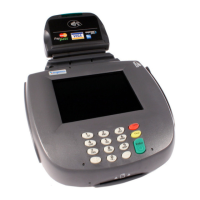
Do you have a question about the Ingenico i6780 and is the answer not in the manual?
| Brand | Ingenico |
|---|---|
| Model | i6780 |
| Category | Payment Terminal |
| Language | English |
Details supported payment types like Credit, Debit, ATM, and EBT.
Guides on viewing security options and serial number related to key management.
Details the default password and procedure to enter the Supervisor Menu.
Explains how to change the supervisor password, with a caution about forgetting it.
Introduces security functions including key injection and check value.
Configures the communication port (COM1, COM2, Ethernet) for key injection.
Details the process of injecting cryptographic keys into the terminal.
Procedure for authorized technicians to inject a new terminal's serial number.
Tests the magnetic stripe reader by swiping cards and checking track reads.
Tests the smart card reader by inserting cards and checking read results.
Tests communication between SAM slots and the SAM micro-controller (SMC).
Introduces the terminal's key architecture, including sponsor keys and key types.
Describes the Sponsor Key (KTK) used for transferring Level 2 keys securely.
Details keys like PEFMK and CEFMK that are loaded encrypted under KTK for terminal-based authentication.
Explains special keys authenticated using application-based options.
Details Secure Text Entry and Clear Text Entry keys used for application-based authentication.
Describes various master keys like MTPK, MMACK, MCK, used for encrypting session keys.
Details working keys (WTPK, WMACK, WCK, Atalla) loaded under master keys for specific operations.
Explains Initial PIN Pad Keys (IPPKs) used for DUKPT engines.
Synopsis of security options like Prompts Authentication, Terminal ID, MACing, etc.
Controls whether authentication keys are terminal or application based for secure data entry.
Controls the existence of financial keys when the terminal ID is re-loaded.
Controls how data entry form prompts are displayed and authenticated.
Controls how code files are updated and authenticated during download.
Controls whether the terminal operates in Visa PED mode for PIN entry security.
Controls whether financial keys are application or terminal based, with a caution about data loss.
Details the steps for validating application code and data files using a secure certificate.
Lists requirements for accepting downloaded files and using download utilities.
Outlines the steps involved in performing a software download.
Step-by-step procedure for initiating and monitoring the software download process.
Lists causes and solutions for errors related to opening communication ports.
Solution for port conflict errors where another application uses the required port.
Troubleshooting steps for issues with non-functional communication ports.
Verifies and resets hardware communication port settings if they have been altered.
Addresses errors related to connection timeouts or failed packet transmissions.
Procedure to compare and correct terminal port settings with download utility parameters.
Signifies a compromised Security Module, requiring RMA for recovery.
Troubleshooting steps for errors when reading cards via the Magnetic Stripe Reader (MSR).
Guides on resolving the "EFT Device Not Available" message on the register.
Specific steps to resolve "EFT Device Not Available" during check authorization.